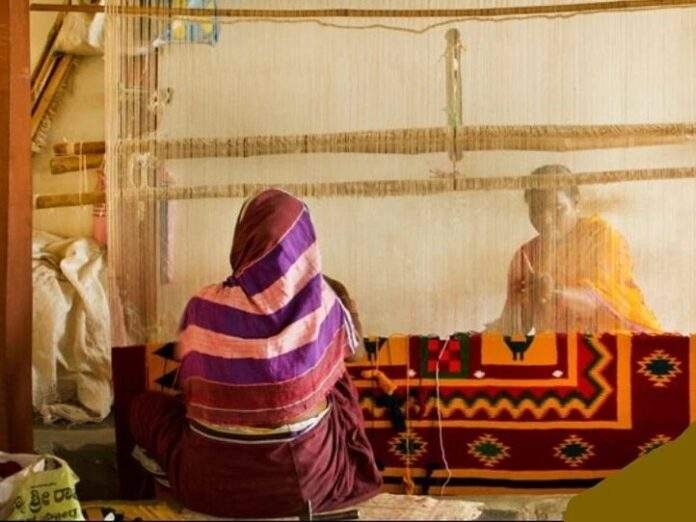India, a land of diverse cultures, languages, and traditions, boasts a rich heritage of art and craft that dates back thousands of years. This vast country’s artistic expressions are as varied as its geography, reflecting the unique customs and lifestyles of its people.
Art and Craft in India
From the intricate designs of traditional textiles to the majestic sculptures adorning ancient temples, Indian art and craft represent a fusion of history, spirituality, and creativity. This article delves into the various forms of Indian art and craft, exploring their origins, significance, and contemporary relevance.
Historical Background
The history of Indian art and craft is a journey through the evolution of civilizations, religious influences, and socio-economic changes. The earliest evidence of art in India dates back to the prehistoric era, with cave paintings in Bhimbetka showcasing primitive human expressions. The Indus Valley Civilization, around 2500 BCE, is noted for its sophisticated urban planning and artifacts like pottery, beads, and seals adorned with intricate designs.
As India progressed through the Vedic period, Maurya, Gupta, and later the Mughal and British colonial periods, each era left an indelible mark on its art and craft traditions. The influence of Hinduism, Buddhism, Jainism, Islam, and Christianity can be seen in the architecture, sculpture, painting, and textiles produced over the centuries.
Diverse Forms of Indian Art and Craft
- Textiles and WeavingIndia is renowned for its rich textile heritage, with each region producing distinctive styles. The intricate embroidery of Kashmir, the vibrant Bandhani of Gujarat, the elegant Kanjivaram silk of Tamil Nadu, and the handwoven Ikat of Odisha are just a few examples. Indian textiles are celebrated for their craftsmanship, vivid colors, and complex patterns.
- Banarasi Silk: Originating from Varanasi, this silk is known for its gold and silver brocade, intricate designs, and opulent appearance. It is often used for wedding sarees and special occasions.
- Pashmina: This luxurious wool from the Himalayan region is soft, warm, and intricately woven into shawls that are highly prized worldwide.
- PaintingIndian painting encompasses a variety of styles and techniques, ranging from ancient murals to contemporary art.
- Madhubani Painting: Originating from Bihar, Madhubani art is characterized by its eye-catching patterns, vibrant colors, and themes revolving around nature, mythology, and everyday life.
- Miniature Painting: Flourishing during the Mughal period, these intricate paintings often depict court scenes, hunting expeditions, and mythical stories. The Pahari, Rajasthani, and Deccan schools of miniature painting are renowned for their distinct styles.
- Warli Art: A tribal art form from Maharashtra, Warli paintings use simple geometric shapes to depict daily life, rituals, and nature.
- Sculpture and ArchitectureIndia’s sculptural and architectural heritage is vast, ranging from the monolithic rock-cut temples of Ellora and Ajanta to the intricate stone carvings of Khajuraho and the majestic grandeur of the Taj Mahal.
- Temple Architecture: Temples in India are not just places of worship but also masterpieces of art. The Dravidian temples of South India, like the Brihadeeswarar Temple in Thanjavur, are known for their towering gopurams (gateway towers) and intricate sculptures. In contrast, the Nagara style of North India, exemplified by the Sun Temple in Konark, features elaborately carved exteriors.
- Bronze Sculptures: The Chola dynasty in South India produced some of the finest bronze sculptures, particularly the Nataraja (dancing Shiva) statues, which are celebrated for their dynamic form and spiritual symbolism.
- HandicraftsIndian handicrafts reflect the country’s traditional skills and creativity, passed down through generations.
- Pottery and Ceramics: Pottery in India ranges from the terracotta figurines of the Indus Valley to the blue pottery of Jaipur. Each region has its distinctive style, with pottery often being used for both utilitarian and decorative purposes.
- Jewelry Making: Indian jewelry is renowned for its craftsmanship and diversity. From the intricate meenakari (enamel work) of Rajasthan to the filigree work of Odisha and the temple jewelry of Tamil Nadu, each piece tells a story of cultural heritage and skilled artistry.
- Woodwork and Carpentry: Traditional Indian woodwork, seen in the ornate furniture of Rajasthan, the carved doors of Kerala, and the bamboo crafts of Northeast India, showcases the ingenuity and dexterity of Indian artisans.
Contemporary Relevance and Global Influence
Despite the challenges posed by modernization and industrialization, Indian art and craft continue to thrive. Efforts to preserve and promote traditional crafts have led to the establishment of various institutions, fairs, and online platforms that connect artisans with global markets. Handloom and handicraft sectors contribute significantly to India’s economy and provide livelihoods to millions of artisans.
Contemporary Indian artists and designers are also redefining traditional forms to appeal to modern aesthetics. Fusion art, where traditional techniques are blended with contemporary styles, is gaining popularity. Indian art and craft have a significant presence in international markets, with exhibitions, fairs, and collaborations showcasing the country’s rich artistic heritage.
Challenges and Preservation Efforts
The art and craft sector in India faces numerous challenges, including the threat of extinction of traditional skills, competition from mass-produced goods, and the economic vulnerability of artisans. To address these issues, various government and non-government initiatives are working towards the preservation and promotion of traditional crafts.
- Government Schemes: Programs like the Handloom Mark Scheme and the Craft Mark initiative aim to authenticate and promote Indian handloom and handicrafts.
- NGO Efforts: Organizations like Dastkar and Craft Revival Trust work at the grassroots level to support artisans, provide training, and create market linkages.
- Education and Awareness: Art and craft education in schools and colleges, along with exhibitions and workshops, help raise awareness and appreciation for traditional crafts among younger generations.
Conclusion
Indian art and craft are not just a testament to the country’s rich cultural heritage but also a living tradition that continues to evolve and inspire. From ancient cave paintings to contemporary art forms, the diversity and creativity of Indian artisans are unparalleled. As we move forward, it is crucial to support and preserve these traditions, ensuring that the vibrant tapestry of Indian art and craft continues to flourish and inspire future generations.
ALSO READ: FAMOUS FEMINIST APARNA DUTTA MAHANTA FROM ASSAM PASSES AWAY AT 75












